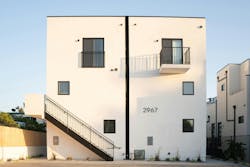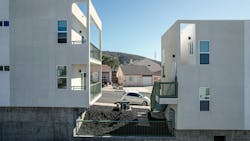San Diego Tackles Housing Affordability by Incentivizing ADUs
In San Diego, the weather is pleasant, the water views are lovely, and affordable housing is hard to find. “San Diego is at the forefront of California’s affordable housing crisis, and California is at the forefront of a national housing shortage,” San Diego Magazine recently wrote.
To help mitigate the crisis, the City of San Diego has created the ADU (Accessory Dwelling Unit) Bonus Program—recently named a winner of the Ivory Prize, which honors innovations in housing affordability.
In San Diego, developers and building owners typically can build only a couple of ADUs per property. But if they successfully gain a permit through the ADU Bonus Program, they can build more ADUs on each lot—with a condition: For every market-rate ADU that’s built, they also must construct an affordable-housing ADU.
San Diego's Accessory Dwelling Unit Bonus Program
The affordable-housing ADUs are deed restricted for either 10 or 15 years: 10 years if the tenants earn up to 50% of the area median income, 15 years if the tenants make 60% to 110% of the area median income.
Since launching in 2021, the program has granted more than 4,000 permits for ADUs.
“No other city in the nation has this program,” says Gary Geiler, assistant director, Development Services Department, City of San Diego. San Diego created the ADU Bonus Program in response to California legislation mandating local jurisdictions to incentivize the construction of affordable ADUs, Geiler explains.
If the ADUs are located within a half-mile of a major transit stop, owners can build as many of the units as they want—up to the zone’s maximum floor area ratio (the building’s floor area in relation to the lot size). If the ADUs are not located in those transit areas, owners can build just one market-rate ADU and one affordable-housing ADU.
San Diego defines an ADU as a unit that’s 1,200 sf or less and provides independent living facilities for one or more persons—including provisions for sleeping, cooking, and sanitation. The ADUs, which can be attached or detached, must be located on a lot with existing or proposed single-dwelling or multiple-dwelling units.
Plus, the affordable ADUs cannot be smaller, inferior versions of the market-rate ADUs. They all must be comparable in size, bedroom mix, amenities, and features. “They have to be like for like,” Geiler says. “The deed-restricted and market-rate ADUs all have to look and feel the same.”
Under the program, San Diego builders and owners are turning both habitable and non-habitable spaces into ADUs, Geiler says. They’re converting garages, for example, or constructing four- or six-unit ADU structures behind multi-unit properties. Some builders are maxing out their ADUs to the 1,200-sf limit, while others are making smaller units of around 600 sf to 800 sf and fitting more units on each lot. While the ADUs can be built on single-family properties, most are going up beside multifamily buildings.
With traditional affordable housing, the units are often scattered throughout new midrise or high-rise buildings. But in San Diego, with so much of the area already developed, most development opportunities must focus on infill housing. The ADU Bonus Program taps the potential for more affordable housing on infill lots, allowing the units to be built in both residential and mixed-use commercial zones.
“Now, we have affordable units in communities that traditionally didn’t have affordable housing,” Geiler says.
The City of San Diego has been working to make the permit-application process smoother and faster, in line with Mayor Todd Gloria’s executive order that limits the processing of all-affordable housing projects to no more than 30 days. “It’s a culture change,” Geiler says. “The City and the Development Services Department are getting all hands on deck to prioritize these affordable housing projects and get them built faster.”
Other cities across the country have been asking San Diego about its ADU Bonus Program—and seeking advice. Here are a few tips Geiler shares:
- Identify the areas in the city where you want the program to take place. Do you want to focus on transit corridors like San Diego does?
- Take a gradual approach. Perhaps start off by allowing just one market-rate ADU for each deed-restricted ADU.
- Consider the area median income in your community to help determine the ideal timeframe for your affordable ADUs’ deed restrictions, whether that’s 10, 15, or 20 years.




